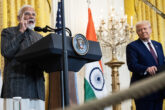December 23, 2017
Expanding US-India Geoeconomic Cooperation Amid China’s Belt and Road Initiative
The United States and India have an opportunity to co-define and co-implement a geoeconomic vision for the Indo-Pacific, based on shared values of freedom and transparency. However, formidable obstacles remain to overcome. Efforts from the United States have been ad hoc and at times self-defeating, such as withdrawal from the Trans-Pacific Partnership (TPP) trade agreement. Furthermore, India’s history and reputation in working with multilateral economic institutions has been mixed, to say the least.
It is in this context that China’s Belt and Road Initiative (BRI)—a trillion dollar infrastructure strategy—has the potential to reshape the future economic and geopolitical landscape of the Indian Ocean rim and Eurasia. Both Washington and Delhi remain skeptical of BRI. Yet neither alone has the resources to effectively shape it, much less put forward a compelling alternative. Only by cooperating together—and with other likeminded partners—can the United States and India develop an effective response to BRI, one that incentivizes China to converge with global norms and standards, cooperates with China selectively, and competes vigorously and smartly where required, all with the ultimate goal of reinforcing the rules-based international order.
Despite some recent high-profile setbacks to several BRI project,1 China at present retains the initiative. Neither the United States nor India has yet to develop a coherent strategy toward BRI. The Obama administration’s regional connectivity agenda amounted to a piecemeal response. Whether the Trump administration will translate a growing focus on BRI into a systematic and appropriately resourced strategy remains uncertain. For its part, India largely views BRI as an extension of a long-term Chinese strategy of encirclement. It has responded by enhancing ties with states across the Indian Ocean Region (IOR) and beyond, as well as by leveraging regional organizations, but these efforts to date are more opportunistic than strategic.
Read the full op-ed in The Asan Forum.
More from CNAS
-
Indo-Pacific Security / Energy, Economics & Security
Trump Unfriends Modi's India: Trump Frothing, India CalmFrom tariffs to tantrums-Trump's latest anti-India tirade stirs global concern. As Washington watches in disbelief, Shiv Aroor discusses what this "break-up" means for India-U...
By Daniel Silverberg
-
Will New Delhi-Beijing Move Beyond Friction Points? | Ex-White Official On India-China Reset
Prime Minister Narendra Modi on Friday said that India and China, as two major economies, must work together to bring stability to the global economic order. NDTV's Gaurie Dwi...
By Lisa Curtis
-
SCO Preview: Modi Heads to China Amid U.S. Tariff Shock
Indian Prime Minister Narendra Modi left Northeast Asia this week, embarking on a two-stop trip that includes Japan and then China, where he will participate in the Shanghai C...
By Derek Grossman
-
Trump’s Lesser-Known Conflicts
President Trump has been focusing on some of the lesser-known conflicts in the world as peace remains elusive for Ukraine and Gaza. Lisa Curtis, senior fellow and program dire...
By Lisa Curtis




